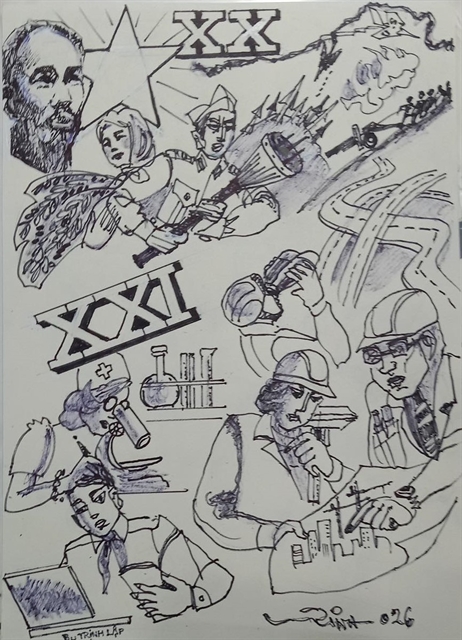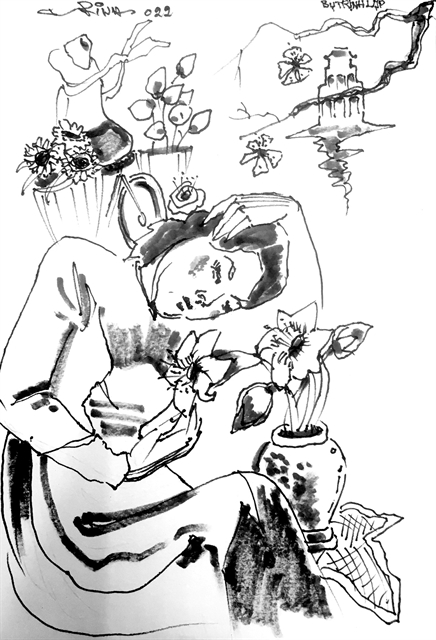 Talk Around Town
Talk Around Town

Hà Nội has the typical weather of the north of Việt Nam with four pronounced seasons, which nurture seasonal plants and flowers all year round

|
| Illustration by Trịnh Lập |
Lê Hương
Hà Nội has the typical weather of the north of Việt Nam with four pronounced seasons, which nurture seasonal plants and flowers all year round.
The capital has been dubbed the City of Flowers, as colourful blooms appear in the city throughout the twelve months of the year.
Popular composer Giáng Son composed her song Hà Nội – 12 Mùa Hoa (Hà Nội – 12 Seasons of Flowers), which names flowers that people can see in every corner of the city.
In the first lunar month, there is peach blossom; the second month has hoa ban (Bauhinia variegata); third month – white hoa sữa or milk flower (Alstonia scholaris); fourth month – white lily; fifth month – red flamboyant; sixth month – lotus; seventh month – hoa sấu (Dracontomelon flower); eighth month – hoa xoan (chinaberry flower); ninth month - Milkwood pine flower; tenth month – chrysanthemum; eleventh month – hoa thạch thảo (European Michaelmas daisy); and the twelfth month – yellow rape flower.
Thinking of flowers in Hà Nội, the images that spring to mind are bicycles slowly driven by women peddling vibrant bunches of flowers; through their hardship, they bear a simple and peaceful beauty, bringing charm to the historic city.
Hanoians love flowers and respect beauty. Even during the wars in the 1960s and 70s, the traditional new year flower market in Hàng Lược Street in the Old Quarter still remained open, such was the local love of flowers.
Though many did not have enough to eat during the tough times of the 1970s and 80s, flowers still blossomed on their balconies.
Many families kept seasonal flowers in their homes. Some simple yellow chrysanthemums or white lilies in a ceramic vase can express Hanoians' elegant character and love for nature.
Hanoians have embraced flowers for the best part of a thousand years. Historian Lê Văn Lan said that to serve the demand for flowers of the people living in the Thăng Long citadel, the Lý Dynasty (1009-1250) set up flower gardens on the outskirts of the royal capital. Thăng Long, now Hà Nội, was surrounded by villages of rice and flowers. They can be seen near today's West Lake.
Urban enlargement has resulted in many new flower villages in Mê Linh, Gia Lâm and Chương Mỹ districts, supplying flowers to the entire city.
Hanoians enjoy flowers in their own way. In spring, to welcome the Lunar New Year festival, you can find a branch of peach blossom or a kumquat bonsai in every living room.
Yet a vase of narcissus was the real symbol of the traditional festival of Hanoians in the past.
It is not simply about watching flowers, bringing natural beauty into the home, but also a way to practise patience and appreciate things as they are.
To have a beautiful narcissus vase, the bulb must be carefully carved to sprout and flower in the ideal way. The 'carver' should know how to control the growth of the bulb according to weather to bloom in time for New Year's Eve. Getting it right is a minor art in itself.
Elderly people say that the delicate fragrance of jasmine, grapefruit flowers, Cholorantus and hoa ngâu (Aglaia odorata) can ease tension and provide a stronger body.
This is why Hanoians put flowers in tea so that it absorbs the fragrance. The most high-end scented tea has the fragrance of lotus, raised in West Lake. It takes lots of time and care to make perfect lotus-scented tea, a delicacy among proud Hanoians.
The streets in the capital are decorated with flowers year-round. In recent years, smartphones have enabled people to take photos quickly. And, of course, it is usually people having fun with beautiful pictures of flowers that take pride of place.
In spring, people take photographs of purple ban flowers near Hồ Chí Minh Mausoleum in Ba Đình District. Then comes white hoa sữa (milk flower). In summer, students enjoy red flamboyant and purple bằng lăng (giant crape-myrtle). Many streets host particular flowers, attracting people to take photos or watch falling yellow leaves.
Over the past few years, Hà Nội has seen many more gardens of flowers like the West Lake Flower Valley, the flower garden by the Rock Area of the Red River, and Long Biên Flower Prairie, where people can pay an entrance fee to bask in the blooms.
The new urban area Ecopark also hosts a significant site for seasonal flowers, where its residents and visitors can come to relax.
In the past few weeks, people have rushed to a new urban area in Hà Đông District, which hosts a road with yellow phong linh (Caribbean trumpet) flowers and red gạo (kapok) flowers.
Flower power
Last week, the National Museum of Vietnamese History launched a 'Kapok Flower Tour' to highlight the beauty of two kapok trees inside the museum's yard, the Indochinese architecture of the museum and antiques displayed at the venue.
Dubbed "A Village inside Streets", the tour offers visitors the chance to enjoy kapok trees in blossom in a space representing a northern rural village with a gate, a tea stall, and folk games.
"Every March, kapok flowers come into full bloom in the museum's ground," said Phạm Thị Mai Thủy, head of the museum's publicity unit.
"The bright red colour of the flowers contrasts with the ancient yellow of the museum's building, creating a wonderful scene. We want to bring a unique experience to visitors."
The tour is unique because it's catered to different groups of visitors: seniors, middle-aged and youngsters. Children even get to see the flowers and play folk games that they had probably never heard of before.
The children can also join a wide range of activities such as drawing, colouring, printmaking, and folk arts.
Visitor Nguyễn Thu Hà enjoys every flowering season throughout the year.
"I go out each month to take photos with the flowers that bloom that month," she said. "I like to create beautiful photos for myself and show off the flowers of Hà Nội. Taking photos is now so easy with smartphones, not like in the past."
Centenarian visitor Nguyễn Văn Hạnh said the trees had, much like himself, been around a long time.
"In the old days, children used kapok flowers to play games together," Hạnh said. "Now we should have tours like this so the children can come and experience the folk games their parents and grandparents used to play."
Nguyễn Minh Châu, 7, said she liked the beauty of kapok flowers and also like to learn about new things.
Culturist Lê Hoài Hương also appreciated the tour.
"Hà Nội can host special flower-themed events every month," she said. "The city has potential for that. Nothing eases stress and keeps people in high spirits more than nature and beauty. Flowers can bring more energy and creativeness to people," she said.
Whether it is spring, summer, winter or autumn; past, present or future, the people of Hà Nội will always revere the city's stunning array of flowers. VNS